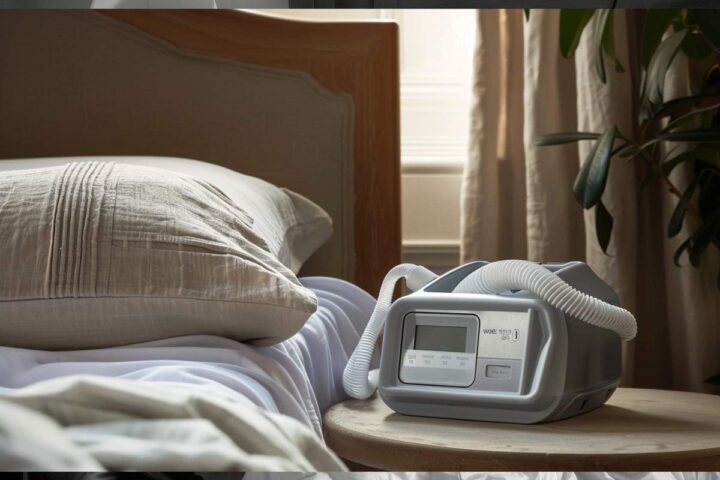
For those who rely on Continuous Positive Airway Pressure (CPAP) machines to treat sleep apnea, finding the right pillow can be a real challenge.
A pillow that complements your CPAP equipment can transform restless nights into deep sleep. Selecting the right pillow is crucial as it not only supports your head and neck but also helps position your CPAP mask correctly, reducing leaks and discomfort. This can make all the difference in ensuring that your therapy is as effective as possible, allowing you to wake up feeling refreshed and rejuvenated.
Let’s explore why choosing the right pillow matters for CPAP users and highlight some pillow types that can make the journey to better rest a little smoother…
Why the Right Pillow Matters
- Comfort and Compliance: The success of CPAP therapy heavily depends on consistent use, termed “compliance” in medical terminology. Discomfort, particularly caused by an incompatible pillow, can significantly lower compliance rates. A pillow that accommodates the mask and hose comfortably can encourage nightly use of the machine.
- Mask Fit and Air Seal: An ill-fitting pillow can push against the CPAP mask, causing it to shift and lose the air seal necessary for effective therapy. The right pillow type provides adequate space and support without interfering with the mask’s position.
- Support and Alignment: Proper head and neck alignment are crucial for preventing airway blockages during sleep. Pillows that offer the right support can align the spine and facilitate easier breathing.
Best Pillow Types for CPAP Users
- Memory Foam Pillows: These pillows are popular among CPAP users for their ability to mold to the shape of the head and neck. Memory foam can provide excellent support and maintain alignment, although they tend to retain body heat and aren’t exactly “eco-friendly.”
- CPAP-Specific Pillows: Specially designed with CPAP users in mind, these pillows often feature cutouts and special contours that help accommodate the mask and tubing. This design minimizes the pressure on the mask and helps maintain a proper seal throughout the night.
- Buckwheat Pillows: An often overlooked but fantastic choice for CPAP users, buckwheat hull pillows offer adjustable loft (provided it has a zippered opening) and excellent support. The buckwheat hull filling allows air to circulate, which helps keep you cool and comfortable. Best of all, the malleable nature of buckwheat hulls means you can adjust the pillow to create spaces for the mask and tubing, ensuring they stay in place without added pressure.
Tips for Using CPAP with the Right Pillow

- Test Different Heights: Depending on your sleep position (side, back, or stomach), the height, or “loft” of your pillow can affect mask alignment and comfort. If your pillow is adjustable, experiment with different heights to find what best suits your setup.
- Try a Breathable Pillow: Stop flipping your pillow to the cool side! Pillows filled with breathable filling like buckwheat hulls allow stay cool all night long. Buckwheat hulls allow air to flow freely, preventing uncomfortable body heat build up.
- Be Persistent: If your current setup isn’t working well, consider making changes. Consistent use is vital for CPAP therapy effectiveness, so it’s important to stay dedicated and explore different approaches to find what best suits your needs.
Choosing the right pillow as a CPAP user can dramatically improve the quality of your sleep and the effectiveness of your treatment. By considering your sleep position and the specific requirements of your equipment, you should be able to find a pillow that helps you sleep better. Whether you opt for memory foam, buckwheat, or a specialized CPAP pillow the key is finding one that makes it feasible to consistently use your machine. Compliance is key!
Good luck finding your perfect CPAP pillow. Please share your experiences with them in the comments below!

What is Deep Pressure Stimulation?
Imagine the serene and cozy feeling of waking under a heavy down comforter on a winter morning. That sense of relaxation isn’t just from the warmth; it’s a result of the weight of the blanket. The consistent and even pressure on your body affects your nervous system, a phenomenon known as Deep Pressure Stimulation (DPS).
Deep Pressure Stimulation involves applying a firm yet gentle pressure to the body. This pressure activates the parasympathetic nervous system. This phenomena has been developed into a therapeutic tool that has been proven to foster a calmer, happier state of mind and can notably improve sleep quality.
Deep Pressure Stimulation can:
- boost “happy hormone”‘ serotonin levels,
- reduce the “stress hormone” cortisol, and
- increase melatonin, which is involved in synchronizing circadian rhythms, including sleep
Whether through holding, hugging, squeezing, or swaddling, DPS can make individuals feel more relaxed and ready for rest, enhancing their overall sleep experience. Initially designed to help individuals with sensory processing disorders like ADHD, DPS has now found broad applications in commercial products for the general populace.
DPS in Sleep Products: Weighted Blankets and Pillows
Weighted Blankets
Weighted blankets are the most popular DPS products in the sleep industry. Designed to be 10-12% of your body weight, these blankets provide a distributed pressure across your body, offering the therapeutic benefits of DPS. Users often report feeling more secure and calm, leading to quicker sleep onset and fewer nighttime awakenings.
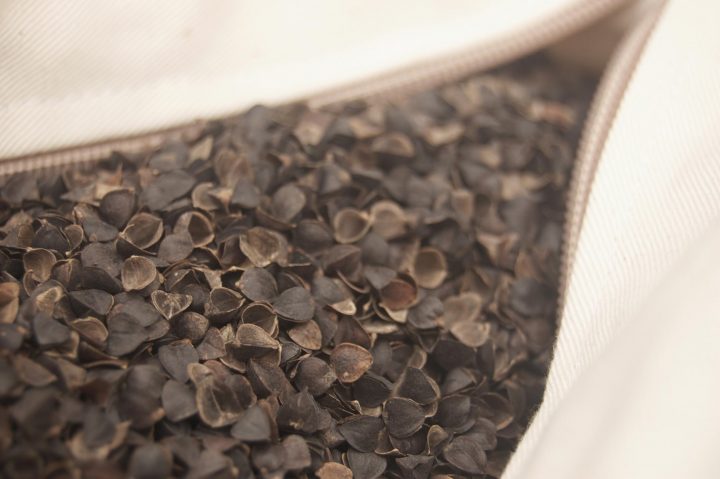
Weighted Pillows
Weighted pillows are filled with dense materials like buckwheat hulls, offering both comfort and versatility. Ideal for both sleep and daytime relaxation, they bring a soothing presence to any space. Like weighted blankets, they apply an even and consistent pressure that can soothe tension when held close.
Additionally, buckwheat pillows excel in their traditional role as bed pillows.
The natural firmness and adaptability of the buckwheat hull filling conforms perfectly to the shape of your head and neck, providing personalized support that lasts all night. Buckwheat pillows’ unique characteristics help in reducing common issues like neck pain and stiffness.

Eco-Friendly and Natural Options
For individuals looking for natural and eco-friendly options to enhance their sleep, buckwheat pillows are a great choice. These pillows resonate with principles of sustainable living, making them a well-rounded, environmentally conscious option for improved sleep.
Embrace Restful Nights
Incorporating Deep Pressure Stimulation into your nightly routine with products like weighted blankets and buckwheat pillows can significantly enhance your sleep quality. As we become more aware of the essential role sleep plays in our overall health, turning to these innovative, natural, and eco-friendly solutions is a smart and effective choice for improving restfulness.

Water pillow? Not as silly as I expected…
Water pillows contain, you guessed it, water. Most water filled pillows are simply a plastic reservoir wrapped with poly foam or a down alternative. Water pillows are popular due to their ability provide unchanging, firm support. Soft traditional pillows containing fill like down have a tendency to collapse under the weight under your head while you sleep, resulting in an uncomfortable downward bend in your neck. Water pillows, on the other hand, are capable of maintaining the same loft (thickness) regardless of how much pressure is applied, keeping your head elevated to an appropriate level.
Water’s incompressible liquid nature offers unique benefits: it can’t be squashed down, yet it is adaptable and will conform to the shape of your head and neck.
Water pillows offer “proof” of improved sleep.
Water pillows are marketed as being “clinically shown to improve quality of sleep.” They utilize keywords like, “pillow for neck pain” to effectively advertise to those experiencing sleep discomfort. Manufacturers cite a 20 year old study conducted by Johns Hopkins University as proof that their products provide improved sleep: Cervical Pain: A Comparison of Three Pillows.
The objective of this study was “to compare three pillows with regard to pain intensity, pain relief, quality of sleep, disability, and overall satisfaction in subjects with benign cervical pain.”
The three pillows types compared were:
- a “standard pillow” — participants were asked to use their current pillow to serve as a reference (the study describes these as “usually a standard down or foam pillow.”)
- a roll pillow — roll pillows are traditionally cylindrically shaped, and approximately 6×15″
- a water-based pillow — the magical pain-reducing, sleep-improving pillow of our dreams
The subjects in the study all suffered from persistent neck pain and were asked to rate both the quality of their rest and perceived pain reduction while using each of the three pillow types.
The study concluded that different pillow types could reduce pain and improve sleep quality. And it did, in fact, show that participants preferred the water pillow to both the neck roll and standard pillows. They perceived better sleep and reduced pain intensity when using the water pillow versus the alternatives.
The study’s results are easy for water pillow manufacturers to exaggerate.
The interpretation of the study used in water pillow marketing is a bit misleading. Yes, the water pillow was superior to the other pillows used in the study, but it’s easy to assert that it didn’t have very strong competition.
To say that the water pillow was better than a foam neck roll or an ill-defined “standard pillow” isn’t really telling us very much.
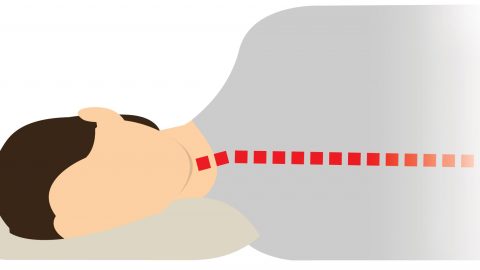
Down and foam pillows do not offer consistent support.
First, consider that the reference group of “standard pillows” filled with down or foam fill are not a good choice for those suffering from neck pain. Both tend to slowly collapse during the night, resulting in inconsistent support. If your pillow is too thin, you’ve likely got an uncomfortable downward bend in your neck. Fold it in half or use two pillows and you’re often stuck with the opposite issue: an upward bend.
It’s understandable that soft down and foam pillows were lumped together as “standard” pillows in the study.
These two pillow types dominated the pillow market at the time the study was conducted. The options have changed pretty substantially in the last 20 years; down and foam pillows are no longer the standard. Their market supremacy has been challenged by other supportive options like memory foam, latex and buckwheat hull pillows. Like water pillows, they all offer support that is superior to down and foam.
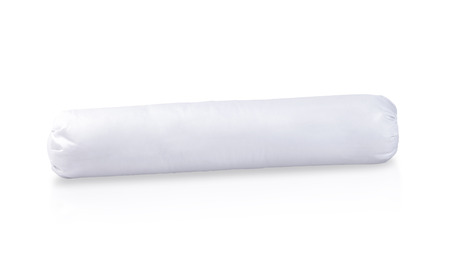
A foam neck roll pillow
The foam neck roll used in the study is an unconventional type of bed pillow that many will find peculiar.
Neck roll pillows are generally not sufficient for use alone as a bed pillow due to their lack of loft (thickness). They’re simply too thin for most. Thus, they’re often used in conjunction with another pillow to provide additional support.
Additionally, in the western hemisphere, most of us are acclimated to rectangular 20×26″ pillows. For this reason a non-traditionally shaped pillow like the neck roll will probably take some getting used to. It’s easy to imagine the participants in the study having trouble acclimating quickly to the neck roll and therefore preferring the water pillow.
My Water Pillow Experience
I bought one! Before I relate my experience, I should acknowledge that I am not currently experiencing any type of neck pain. Thus, I’m not really qualified to say if a water pillow is truly more effective than a neck roll, down or foam pillows at reducing pain. I can, however, tell you if it’s supportive and comfortable!
I’d read about water pillows before, but this was the first time I tried one for myself. I did a little research and picked what appeared to be the best one available. It had favorable reviews and seemed like a reputable brand.
When I pulled it out of the box, the water pillow didn’t seem any different than a traditional foam pillow.
It was very soft and about 4″ thick without any water in it. I turned the pillow over and discovered a small circular cap which allows it to be filled with water. The instructions showed that I should unscrew the cap and replace it with a small included funnel. The amounts of water required for soft, medium and firm were indicated but I didn’t bother measuring. Instead, I filled it straight from my kitchen sink’s faucet until it seemed appropriately full. I pushed the excess air out of the water bladder and carried it to my bedroom.
It was a bit too thin at first… As a side sleeper, I need a high loft, firm pillow. I added a bit more water. After a few trips back and forth to my kitchen, I managed to adjust so that the loft seemed just right.
Most pillows aren’t adjustable like this. Despite a bit of extra effort, I really appreciated the ability to fine-tune the water pillow’s loft.
A water pillow is hefty.
Once filled to my preference, it weighed 10.5 lbs. Personally, I don’t its heft a disadvantage, but if you like to move your pillow around, you might consider it a shortcoming. I will admit that I was a little nervous about moving it because its seams and fabric didn’t look particularly durable.
Water pillows are supportive.
I was immediately able to feel a water-based pillows’ benefit. You sink your head into it and you don’t have to worry about it collapsing under pressure the middle of the night. Water is incompressible, so whatever loft you’ve fine-tuned is what you’ll get, consistently, night after night. Your head will be elevated just as you like it.
Water makes a unique sloshing sound.
The instructions made it clear that I needed to remove all the air from the pillow or it’d make some noise. Even with all the air squeezed out, it’ll make a bit of noise when you move around on it. Some reviewers complain about the sounds produced by a water pillow, but I didn’t find it distracting in the least. In fact, I thought the sounds were rather soothing. Maybe I built up a tolerance in 80s when I slept on a waterbed!
The fiberfill overlay was way too compressible and far too soft for a side sleeper like myself.
The fiberfill wrapped around the water bladder was far too squishy for my preference. When on my side, my head would sink deep into the soft fill until it met the resistance of the water bladder. The sides of the pillow would push uncomfortably against my face. It made me feel slightly claustrophobic. I would have preferred it wrapped in less of the fiberfill.
Even when the water bladder is filled with a minimum amount of water, I imagine it would be too thick and soft for most stomach sleepers. Accordingly, most water pillows are probably best suited for back sleepers.
A water pillow is not moldable.
I found the lack of moldability to be the water pillow’s biggest disadvantage. I couldn’t squish the pillow into the shape I desired because the water contained in the bladder always bounces back into the same rectangular shape. The fiberfill wrapped around the bladder offered a little bit of moldability, but it’s nothing like other malleable fill types like down or buckwheat.
Does a water pillow have a cooling effect?
The water pillow manufacturers don’t list cooling as a benefit, but It seemed like a possibility. I’d tested a cooling pillow insert filled with water before and thought that perhaps this water pillow might have a similar cooling effect. This turned out to not be the case. When not in use, the water contained falls to room temperature and will feel quite cold to the touch due to the physics of heat transfer. However, the fibrefill acts as insulation between the water and your skin. As a result, there is no perceptible cooling effect.
After reading the product literature more carefully, I discovered that the water bladder was covered with a thin thermal insulation. This helps to prevent heat transfer to the water. It actually felt a bit hot compared to my favorite pillow, which sat quietly on the floor waiting for the water experiment to run its course. That said, I doubt it’s any worse at staying at a comfortable temperature than most pillow types.
Water Pillow Verdict: Sink or Swim?
Water Pillow Benefits:
- Supportive — I’d say it’s a water pillow’s best attribute. Provided you’ve taken the time to fill it properly, a water pillow will consistently keeps your head elevated at just the right level all night long.
- Supposed Pain Relief — I wasn’t able to determine if my water pillow was indeed capable of reducing pain, but the many positive reviews online (and even the Johns Hopkins study) suggests a genuine benefit.
- Adjustable — Not many pillow types are adjustable. This is a big advantage. It can be very difficult to find the pillow that’s just right for you-they’re always either too thick or thin!
Water Pillow Negatives:
- Not moldable — There are no options with a water pillow-it won’t change shape. That pesky water always bounces back.
- Some types may be wrapped in a fiberfill that’s too soft — My water pillow was covered in a super soft fill that pushed upward awkwardly into the side of my face.
- Leaks (potentially) — I read several water pillow reviews online that mentioned leaks. A wet mattress and flat pillow aren’t conducive to good rest!
I was genuinely impressed with my water pillow. I’m certainly no convert, but I admit it wasn’t the gimmick that I expected it to be. I’ll be sticking with my buckwheat pillow.
As for the water pillows’ “proof” of superiority…
The results of the study show a preference for the water pillow compared to neck roll and “standard” pillows. I think it’s reasonable to assume that the participant’s preference for the water pillow was due specifically to their:
- adjustable loft. Being able to adjust your pillow so that you’re positioned in a neutral sleeping position is a big deal. Without adjustable loft, or very careful pillow purchases, you’re most likely sleeping on a pillow that is either too thick or too thin.
- consistent and comfortable neck and head support. The study states that, “…if neck pain is exacerbated during sleep by poor head and neck support, then it is not surprising that individuals frequently awaken experiencing increased morning headaches and neck pain.” Proper, consistent head and neck support makes a big difference in quality of sleep.
20 years ago, maybe the water pillow was the best solution for many. Today we have far more pillow options that can provide the same or better benefits.
What are some good alternatives to water pillows?
Many other supportive pillow types can work just as well if not better than a water pillow. Those considering a water pillow should also look into:
- buckwheat hull pillows. These unique, all natural, adjustable pillows are many chiropractors’ favorite.
- memory foam pillows. OK, I’m admittedly not super enthusiastic about these due to their potentially toxic components, but some swear buy them!
- latex pillows. Latex pillows are derived from the rubber tree and are very similar in feel to memory foam, sans toxic chemicals.
- contour pillows. Contour pillows are molded in a concave shape that’s meant to cradle and keep your head in a consistent position.
Read More: Perfect Your Sleeping Position with an Orthopedic Pillow

Make a fantastic vacation just a little more comfortable with your buckwheat pillow
Sleepers all over the world are enjoying the benefits of buckwheat hull pillows for a restful night’s sleep. Buckwheat hull filling is firm and moldable, conforming perfectly to your head and neck. Buckwheat hulls provide exceptional support that traditional pillows simply can’t match.
As buckwheat pillows have grown in popularity, many users have found themselves reluctant to leave their comfortable beds to travel. Fortunately, buckwheat travel pillows are now on the market that you can take on airplanes or squeeze into automobile trunks. These small, easily portable sleep enhancement products will make any vacation better.
Whether you already own a buckwheat pillow or you’re thinking about purchasing one, consider these benefits before booking your next trip:
Sleep Upright
 Whether on an airplane or in an automobile, travel frequently requires hours of sitting in an upright position. A travel pillow made from buckwheat provides comfort no matter where you’re trying to sleep. These pillows are more versatile than a traditional one, allowing you to easily shape it to conform to a car or airplane seat.
Whether on an airplane or in an automobile, travel frequently requires hours of sitting in an upright position. A travel pillow made from buckwheat provides comfort no matter where you’re trying to sleep. These pillows are more versatile than a traditional one, allowing you to easily shape it to conform to a car or airplane seat.
Back Support
The neck isn’t the only area of the body that suffers during a long trip. Hours in a seated position can take a toll on your lower back, causing pain that lasts for days after you depart the car or plane. This can disrupt your vacation if you have to spend days resting after the long trip. By placing a buckwheat travel pillow in the small of your back, you can support your lower spine while you’re traveling. This will keep back pain at a minimum so you can enjoy every minute of your trip.
Adjustable
When it comes to pillows, each person has their own preferences. You may like a thick, lofty pillow while your spouse prefers one that only offers slight elevation. The best buckwheat travel pillows come with a zippered case that allows for easy removal and replacement of the hulls inside. Because the buckwheat hulls can be added or removed, you can customize the pillow to your own personal preferences.
Fresh and Clean
Comfort aside, many people take their own pillows and bedding along with them for hygiene purposes. While most hotels wash pillowcases, sheets, and blankets between guests, the pillows themselves are left untouched. For those who are particular, a personal pillow is a great solution. Buckwheat travel pillows guarantee a clean pillow no matter where the person is sleeping.
Washable
 One of the many things that makes a buckwheat pillow better for traveling is its washability. The hulls can be removed at any time and set in the sun to refresh, while the pillowcase can be unzipped and removed for washing. This is especially important when traveling, since a pillow will often be exposed to debris and dust in airports, hotel rooms, and even while in transit from one location to another. Learn more about how to clean buckwheat pillows.
One of the many things that makes a buckwheat pillow better for traveling is its washability. The hulls can be removed at any time and set in the sun to refresh, while the pillowcase can be unzipped and removed for washing. This is especially important when traveling, since a pillow will often be exposed to debris and dust in airports, hotel rooms, and even while in transit from one location to another. Learn more about how to clean buckwheat pillows.
Breathability
Buckwheat pillows are well known for their ability to keep a person’s neck and head cool. The buckwheat hull fill allows better air circulation than other pillow types, keeping them cooler, whether you’re sleeping in a bed or on the beach. Where traditional pillow fill types, like down or polyester, trap a person’s body heat, buckwheat hull pillows stay cool.
They’re ideal for visiting warm, tropical locations. You can take a buckwheat travel pillow to the pool or the beach for comfortable lounging throughout the day. The pillow supports your neck better than a lounge chair or a towel on the sand, keeping you comfortable as you’re basking in the sun.
For even better results, make sure your pillow has a case made from 100 percent cotton. Our own Hullo™ travel pillows are made with organic cotton to provide a cooler resting experience.
Versatility
Buckwheat travel pillows shouldn’t be reserved for use during travel. Their small size makes them perfect for use by the young people in your life. Some of the buckwheat hull fill can be removed to meet their own preferences. Buckwheat travel pillow owners have also found they’re the ideal size for use while reading or watching TV. You can keep a travel pillow near your sofa in the living room to grab when you need extra support while lounging. Since your standard-sized buckwheat pillows will be on your bed, you won’t have to move it to the living room when you need to get comfortable.
Whether you own a buckwheat pillow or you want to try one out, a travel pillow is a great addition to your collection. You’ll be able to experience comfort, no matter where you’re resting. Because these pillows are so easy to clean, you can wash them when you arrive home, removing all dirt that accumulated while on the road.
Hullo™ small buckwheat pillows, at 14×20 inches, are the perfect size to take along on the next business trip or then your family vacation in paradise. Also consider our buckwheat bolster pillow, a versatile travel companion that will keep you comfortable wherever you find yourself.

Enjoy that sleep while you can get it, lady. Your neck is going to be really sore after sleeping on that mountain of a pillow.
Finding the best side sleeper pillow can be an overwhelming experience. There are hundreds of different types of pillows to choose from and separating the good from the gimmicks isn’t easy. The wrong pillows can potentially cause or worsen headaches, neck and shoulder pain, arm numbness, general discomfort and even sneezing.
Your precious rest is at stake, so choose wisely!
First, consider your sleeping position.
The reason we sleep on pillows is because they help to keep our head elevated in neutral alignment while we sleep. Ideally your head should be perpendicular to your shoulders and your neck should not be bent too far in any direction. For side sleepers, the pillow fills the gap between your ear and the bed, keeping your body consistently and comfortably aligned.
Sleeping with a pillow that is too soft or thin will cause your head to lay too low, creating a downward bend in your neck. Conversely, using a pillow that’s too thick will create an upward bend. Neither is comfortable or conducive to restful sleep. These circumstances can cause excessive stress on your neck and shoulders which can potentially cause pain.
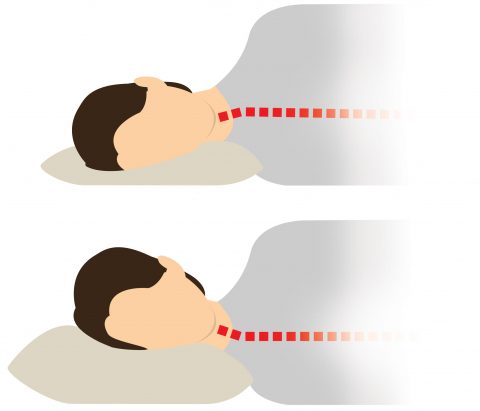
If your pillow doesn’t keep your head at the correct level, it is likely you will experience back and neck pain.
What’s the best side sleeper pillow?
Side sleepers generally require a firmer, fuller pillow than back or stomach sleepers. This is simply because there is considerably more space to fill between your head and the bed while on your side. Soft or thin pillow types do not provide adequate support for most side sleepers because their head is inevitably positioned too low.
The ideal side sleeper pillow:
- provides enough loft (height) to keep your spine straight, but isn’t so thick that it bends your neck upwards out of alignment.
- remains supportive throughout the night. The fill does not collapse under the weight of your head, creating an uncomfortable downward bend in your neck. Firm pillow filling types are best at providing consistent support that doesn’t flatten out while you sleep.
- is comfortable. Ultimately, it’s best to trust your instincts. If a particular pillow works well for you, stick with it.
Go pillow shopping.
You’ll quickly discover that there are hundreds of different pillows designed specifically for side-sleepers. Of these, many come with a predetermined shape, meant to conform to the shape under your neck. Before you spend your hard-earned money on these, keep in mind that most people change position frequently during sleep. While you might prefer to be on your side, it’s quite likely that you move to your back and stomach many times throughout the night. These pillows are designed to work best while you’re lying perfectly perpendicular to your mattress. They only work well for those that hold a relatively static sleeping position during the night.
For most, a malleable side sleeper pillow with down, shredded latex, or buckwheat hull fill will be preferable. These pillow types will allow you to mold your pillow into a shape that’s comfortable and provide firm and persistent support.
Two tips that’ll make your side sleeper pillow choice simpler:
- Sleep on it. It’s impossible to test pillows online or even in a store. The best manufacturers will allow you to try their pillows in your home with a money-back guarantee. Sleep with the pillow in your own bed to determine if it’s right for you.
- Look for an adjustable pillow. Unfortunately you can’t adjust most pillows on the market. Some pillows allow fill to be added or removed through a zipper opening. This allows you to alter the both firmness and loft of your pillow to your personal preferences.
Sleep on it!
It’s very easy to end up with a pillow that’s either too thick or too thin. There really is no substitute for literally “sleeping on it.” Squeezing a pillow inside plastic packaging at the store isn’t the way to find your ideal pillow. You really need to test drive them in your own bed if possible. Check the manufacturer’s return policy and make sure that you’re able to try it for at least a week. If it’s not right for you, toss it back in the box and return it. You spend a third of your life with your head resting on a pillow, so a little shopping and experimentation is absolutely worth it.
The best side sleeper pillows will provide support for both your head and neck. Above all, it’ll simply be comfortable. If you’re careful and deliberate with your purchase, you’ll get the most restful sleep possible. Trust me, it’s worth it!
As I side sleeper, I prefer our own Hullo buckwheat hull pillows, but don’t take my word for it, check out this review (and many others):
“I am a side sleeper and before getting a buckwheat pillow, I always used two pillows and/or folded my pillows in an attempt to support my head properly. I can quickly shape Hullo with my hands and find a comfortable sleeping position. Before the buckwheat pillow I would wake up with a numb arm, or sometimes a sore neck. This doesn’t happen with Hullo.
Now I take my Hullo wherever I go, because soft foam and feather pillows aren’t as comfortable. I highly recommend trying this pillow.” – Hullo customer, Nicholas

The dimensions of a “standard” pillow are 20″x26″
There are three popular buckwheat pillow sizes: small, standard and the king
Small Size 14×20″ Buckwheat Pillow
Years ago, I ordered my first buckwheat pillow. I assumed I was getting a standard-sized 20×26″ pillow, but I had unintentionally ordered one half that size. It was comfortable and I fell in love with it, but still felt a bit too small for my larger stature. I’m pretty tall (6’2″) and a side-sleeper; I suspected a larger pillow would provide better support for me.
For someone with a smaller stature, however, a small buckwheat pillow can provide more than adequate support. A smaller pillow has an advantage in that it’s considerably less bulky than a larger one. A 14×20″ buckwheat pillow weighs half what a 20×26″ pillow does and is pretty easy to shift around while in your bed. My kids both use small buckwheat pillows and prefer them to the larger size simply because of the weight advantage.
Worth noting: I’m willing so sacrifice the bedroom’s aesthetics for comfort any day, but my wife wasn’t particularly thrilled with the idea of this new odd-sized pillow that didn’t fit our bedding set. You can certainly find plenty of 14×20″ pillow cases in flat colors at large retailers like Amazon, but you aren’t going to get the latest designer patterns.

Hullo™ Is Available in Small (14×20″), Standard (20×26″), and King (20×36″) Sizes
Standard Size 20×26″ Buckwheat Pillow
After many years of industrial production, the most popular or “standard” pillow dimension emerged: 20×26″. Most North American consumers, myself included, prefer a standard-size pillow. A good deal of that preference, I’m sure, is due to acclimation. We grew up with these things; what’s familiar is comfortable.
Soon after getting my small buckwheat pillow, I decided I’d be better off with a larger one and made my own standard-sized pillow, which ultimately became the first Hullo prototype. While considerably more bulky, (around 8.5 lb.), I found it to be even more comfortable than the small one. It contained considerably more volume which allowed for better support over a greater surface area. Of course, it also fit inside my wife’s beautiful new pillowcases and looked great on our bed.
We definitely see a preference for the standard size in our Hullo customers. The sales numbers tell us that the standard size works best for most.
King Size 20×36″ Buckwheat Pillow
A king size buckwheat pillow is substantial—it’s a full 10″ wider than a standard pillow. Not only are they large, they’re heavy—a full pillow weighs around 14 lb. They’re not easy to toss around (forget about pillow fights), but the fact that it’s so long makes moving it less necessary. You can roll over and keep on rolling. Like a standard size buckwheat pillow, they’re capable of providing plenty of support for taller sleepers. They of course fill up the space on a king size bed and fit those awesome new shams your mother in law just got you for Christmas!
So What’s the Best Choice?
If the pillow is for a child or someone on the petite side, I’d definitely recommend a small. Those who want to fill up their gigantic sleigh beds should get a king. For most, a standard size buckwheat pillow is best. It’s what I use and I sleep pretty well at night.
Hullo™ is available in three sizes and starts at $59 with free shipping.
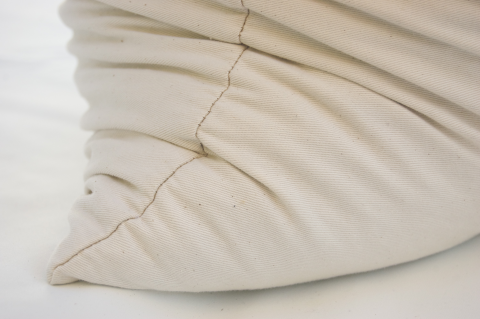
Look for heavy-duty materials and construction that is designed for the added weight of a buckwheat pillow.
One of the great things about a buckwheat pillow is that it can last many years. Not only are they supremely comfortable, they can be cheaper in the long run than traditional pillows that must be replaced much more often.
A Buckwheat Pillow Case Must Be Well Made
Buckwheat pillows are relatively hefty:
- small buckwheat pillows (14×20″) weigh about 4 lb.
- a standard size (20″x26″) about 8.5 lb.
- and the monstrous king size (20×36″) can weigh as much as 15 lb.
Pillow cases made from traditional materials and construction techniques simply cannot carry this much weight. Seams can split and zippers may separate, making a big mess. Worst of all, you’re potentially without your precious buckwheat pillow. I’ve had it happen before. My first buckwheat pillow wasn’t the best quality, and it tore at the seam.
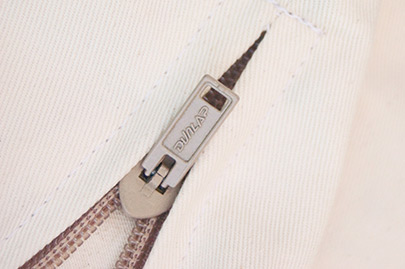
High-quality Dunlap zipper
Unfortunately most of the buckwheat pillows available today do not make any mention of the quality of the pillow case itself. Most are using cheap materials appropriate only for use with down or foam pillows.
If you’d like your buckwheat pillow to last as long as possible, make sure to purchase one that utilizes a thick cotton pillow case with a strong zipper. Otherwise, you might end up with a pile of loose buckwheat hulls in your bed.
We recommend our own Hullo buckwheat pillows which are constructed using:
- extra-strong reinforced double stitching.
- 100% organic cotton twill (7 oz. weight).
- a heavy-duty Dunlap hidden zipper.
